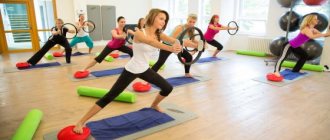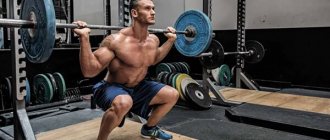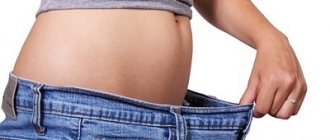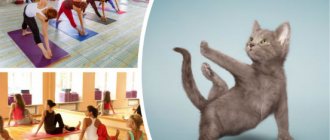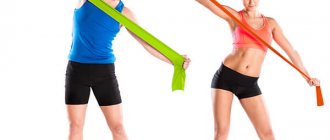One of the causes of varicose veins is a low level of physical activity. However, during the treatment process this factor can be eliminated - it is enough to perform specially designed exercises for patients with varicose veins under the supervision of the attending physician.
Such loads allow you to lose excess weight, improve overall well-being, and normalize metabolism. However, it is important to remember that not all types of physical activity will be beneficial for varicose veins. Therefore, to choose a particular set of exercises, you should follow the recommendations of a specialist.
Why is physical therapy needed?
Performing exercises recommended for varicose veins helps achieve the following results:
- getting rid of obesity;
- normalization of blood pressure and heart rate;
- improvement of venous and lymphatic outflows;
- increased venous tone;
- strengthening the muscle frame;
- normalization of microvascular circulation;
- increasing the patient’s overall level of physical activity.
Neglecting gymnastics for varicose veins of the legs is extremely undesirable. Otherwise, the patient cannot avoid the occurrence of swelling and pain.
This is a manifestation of the so-called “stagnation” phenomena, when excess fluid accumulates in the body, which weak veins cannot cope with. These processes further aggravate the course of the disease, which, of course, cannot have a positive effect on the patient’s condition.
Top products for varicose veins
To support the healthy state of blood vessels, it is necessary not only to properly think through the training process, but also, if possible, to include the following products in the diet:
Buckwheat. Contains substances important for veins - amino acids, proteins and the flavonoid rutin, which help eliminate spider veins and stimulate tissue regeneration.
Beet. Regular consumption of beets helps prevent varicose veins. When the disease occurs, the body contains a large amount of the amino acid homocysteine, which can aggravate the course of the disease. The vegetable contains a phytochemical compound, betacyanin, which suppresses the production of homocysteine.
Avocado. It is one of the most popular products against varicose veins. Contains many useful substances. The vitamins C and E included in the composition help strengthen the protective functions and nourish the walls of blood vessels. Glutathione acts as an antioxidant and prevents damage to arteries and veins.
Asparagus. Has strengthening properties for blood vessels. The highest concentration of beneficial natural substances is found in the young plant.
Ginger. It is a natural fibrin solvent. Varicose veins are characterized by poor circulation and blood thickening. The composition of ginger allows you to activate blood flow and fluidity. Often used with primary therapy to treat varicose veins.
Blueberry. Blueberries are a source of biologically active substances - vitamin E, anthocyanins, which help normalize the nutrition of vascular tissues, strengthen them, restore and enhance protective functions. Consumption of therapeutic nutrition will help enhance the beneficial effects of the main course of therapy against varicose veins.
What should we not forget when performing exercise therapy?
You should know that patients who have never engaged in sports or physical activity before should begin to do exercises gradually, without intense exercise. The best option in this case is walking in the fresh air or on a treadmill.
Exercises in a swimming pool are also well suited, since in water the load on the muscles is distributed evenly, and body weight practically disappears. This is the peculiar uniqueness of the aquatic environment and its benefits for beginners in sports activities.
Before you begin performing new types of physical activity, it is advisable to familiarize yourself with a number of certain rules: they will allow you to achieve maximum effect and also reduce the risk of injury. So, patients must adhere to the following guidelines:
- before each lesson (the same as after it, but with additional stretching exercises), a warm-up should be carried out for 5-10 minutes;
- you can increase the complexity and intensity of exercises only gradually, after the body adapts to the loads;
- during gymnastics, you should drink the required amount of water, avoiding dehydration;
- if your heart rhythm is abnormal, it is better to stop doing exercises and rest a little;
- the number of approaches is determined depending on how you feel;
- The first lesson is conducted together with a specialist in therapeutic physical education (PT).
In order to monitor the dynamics of your achievements, you can keep a diary of your daily activities. However, we should not forget that in any case, the best guideline is how you feel.
Useful and prohibited sports
To prevent the development of venous insufficiency and prevent the worsening of existing varicose veins, you need to adhere to high physical activity. For this disease, the following sports are considered useful:
- Water aerobics is the most preferred fitness option for patients with varicose veins. Water improves the elasticity of the skin, adds firmness to it, and helps blood flow.
- Walking (on a treadmill, in the park, Nordic). Any type of this physical activity reduces pressure in the veins and helps the vascular valves work properly.
- Yoga. All phlebologists approve of it, since the slow pace is combined with exercises on elevated legs, which promotes good blood flow.
- Pilates for varicose veins will replace your usual fitness routine. The advantages of Pilates are its calm rhythm and the absence of strong stress on the legs.
You cannot do:
- step aerobics;
- fast running or long distance running;
- powerlifting.
These types of activities are contraindicated for varicose veins due to the negative impact on the walls of blood vessels: due to heavy loads, pressure increases, the walls stretch, which leads to the formation of new venous nodes.
General training complexes
There are exercises that are effective for varicose veins that appear on any part of the body. They are given approximately 15-30 minutes daily.
- In a lying position, place your arms parallel to your body. In a straightened state, the right leg is pulled up to the chest as much as possible. Next, the pose is fixed. Then you need to bring the lower limb into a position perpendicular to the floor for 10-15 seconds. Similar actions should be repeated with the second leg.
- In the previous position, you need to smoothly pull your legs towards your chest, having first bent them at the knees, then straighten them, and fix this position for 1-2 seconds, then relax and lower them.
- Also, in a lying position, you need to raise your legs as high as possible. The exercise involves the feet: they synchronously make circular movements for 5-10 seconds. Remaining in the same position, you should bend and straighten your toes.
- While sitting (on a chair), straighten your back. Press your heels firmly to the floor. Move your toes left and right 15-20 times.
- Lying down, roll over onto your stomach, place both hands over your torso, and press them tightly to your thighs. Raise your legs up one by one (try to do this as much as possible). Moreover, it is advisable to linger a little at the highest point of the amplitude of the lower limb. The movement should be repeated 8-10 times.
- Slowly stand up, place your arms along your body. Next, spread your upper limbs to the sides in order to feel the balance. After this, you need to try to move your right leg back. In this case, the torso should lower as parallel to the floor as possible. For beginners, such a task may seem impossible, so to simplify it, you can find support with one hand and balance with the other. You need to stay in this position for 5-10 seconds (for each leg).
- While standing, you should roll from heel to toe, smoothly transferring your body weight. (15-20 times).
- Place your hands on your hips. Then you need to try to walk on your heels for 10-15 meters. Next, without stopping the exercise, you should repeat it “on tiptoe.”
The workout ends with high-knee steps.
Mikulin's jumps
In the fight against varicose veins, academician Mikulin’s vibration gymnastics has proven itself to be excellent. Special exercises for legs with varicose veins include only special jumps, the regular implementation of which will help eliminate the symptoms of varicose veins.
- After waking up, you need to stand up straight, stretch your arms along your body, and when you inhale, rise on your tiptoes an inch. As you exhale, sharply lower your legs to the floor.
- When you hit your heels, the body will receive a slight jolt, the push will direct the blood upward through the vessels, and as a result, the vessels will be cleansed from the inside.
- Special Mikulin jumps must be done at least 60 times a day; the exercise should not be turned into intense jumping. Movements should be smooth, neat, every 20 pushes - a break of 10 s.
Such exercises are useful in combination with exercises for varicose veins of the small pelvis, which often develops during secondary and subsequent pregnancies, with a strong load on the pelvis.
A set of movements for the veins of the lower extremities
There are also special exercises designed to be performed by patients with varicose veins of the legs, which are necessary to strengthen the muscle frame and relieve the strain on the veins.
- You should organize a kind of “support” from pillows or a rolled blanket, then lie down with your lower limbs on it and relax. This manipulation must be performed for 10-15 minutes to allow blood flow to flow from the feet to the torso.
- You need to take the starting position - lie on your back and bend your knees. In this case, the feet should be pressed firmly to the floor surface. As you inhale, the head and upper torso lift off the surface, and the arms are aligned with the hips. As you exhale, you should return to the original position. Five repetitions of the exercise are enough to activate the muscles.
- For the next approach, you will need a volleyball or a light pillow. While in a lying position (without changing it), press your hands tightly to the floor, hold the object with your feet, and then lift your legs off the surface slightly higher than your torso. You should try to stay in this position for a few seconds. When exhaling, return to the starting position.
- The following exercise will allow you to activate the work of the abdominal and pelvic muscles: lying with your knees bent, you need to inflate your stomach while inhaling and deflate as much as possible when exhaling.
- In a standing position, place your arms along the body. As you inhale, you need to transfer the weight to the fingertips of your lower extremities, and raise your arms up (while trying to stretch out completely). As you exhale, slowly return to the starting position.
It is important to remember that the exercises recommended for varicose veins of the lower extremities should be carried out in conjunction with breathing control: while the patient performs gymnastics, his body experiences increased saturation of tissues with oxygen, as a result of which oxidative stress is eliminated.
General principles of performing exercises to enhance venous tone
Leg exercises are done for chronic varicose veins in the morning and before bed. In the morning it helps to tone muscles, speed up blood flow in the legs, and in the evening it strengthens the vascular system and relieves heaviness and swelling. If the patient does not feel well or has very severe pain in the lower extremities, then exercise should be abandoned. However, systematicity is still extremely important, since certain reflexes and habits are developed in the body itself and, in particular, in the vascular system. Before charging, each time you need to squat for 20-30 seconds. When the patient stands up, blood flow in the legs will increase sharply.
You should adhere to the basic principles that will help you perform gymnastics correctly:
- Exercises for varicose veins should be done in a well-ventilated area;
- the total charging time should not exceed 15-17 minutes;
- you can do exercises in elastic socks, stockings or special underwear;
- it is important to measure your pulse while charging (the norm is 115-125 beats/min);
- you should strictly monitor your breathing during physical activity, you need to breathe evenly, deeply and without breaks, so as not to deplete the body of oxygen;
- take a short break every 4-5 minutes to allow the muscles to relax;
- the effectiveness of charging will be enhanced by the cream for varicose veins;
- You need to start classes with a light warm-up, gradually increasing the load;
- the number of repetitions should be adjusted to suit your well-being and stage of the disease;
- after finishing the exercise, it is important to keep your legs “at height”, lie down, placing them on a pillow or towel roll;
- with trophic ulcers, physical activity is prohibited.
A set of physical activities for the upper limbs
As you know, varicose veins can affect not only the lower extremities. The vessels of the upper body can also change their structure due to this disease.
To enhance the therapeutic effect of the therapy, you should spend 10-15 minutes daily on special exercises, which includes the following manipulations:
- Take a lying position, then raise all limbs up. You need to hold this position for 20 seconds. Then, after this time, you need to shake your arms and legs and then lower them.
- To easily warm up your core muscles, you need to put your hands behind your head and clasp your fingers together. Alternately, you should turn your body left and right about 20-27 times. Professionals call this exercise “crunches.”
- Maintaining the same position, extend your arms in front of you, spread your fingers wide to the sides, then slowly clench them into a fist. To activate the work of the vessels of the upper extremities, 20 repetitions will be enough. In this position, the valves of the veins normalize the direction of blood flow, as a result of which the lumen of the vessels decreases.
- Another variation of the previous exercise: after eighty squeezing and unclenching of the hands, you need to lower your arms along your body and repeat the work of your fingers. This complex is necessary to give a “shake-up” to weakened veins - changing positions forces the muscle elements that make up the walls of the vascular branches to work.
How to identify varicose veins
The symptoms of varicose veins are quite clear, and it is easy to diagnose. The main signs of the disease are as follows:
- pain in the lower extremities;
- legs that swell by the end of the day;
- thickening of the veins and their protrusion on the skin of the legs;
- the skin of the legs acquires a bluish tint;
- constant feeling of heaviness.
Even just one of these signs is a reason to sound the alarm. Varicose veins lead to discomfort not only in the legs - it can cause extensive expansion of veins, circulatory disorders, and the development of thrombosis and thrombophlebitis. If the disease is not treated, swollen blood vessels can burst and cause bleeding. There are even cases of death due to bleeding in especially advanced cases of varicose veins.
Typically, treatment should be comprehensive and include the following methods:
- Use of medications;
- Ointments and creams for external use;
- Vitamins;
- Special exercises for varicose veins on the legs.
The main goal of therapy is the improvement of blood vessels. Healthy blood vessels help prevent a number of problems associated with both varicose veins and a number of other diseases.
How to get rid of pathology of the pelvic veins?
Useful gymnastics for patients with varicose veins may also include tasks to develop the muscles and blood circulation of the pelvic floor.
- The “bicycle” exercise, known to everyone since childhood, consists of simulating riding while lying on your back. It is important to ensure that the lower back and buttocks are pressed firmly to the floor. To make it easier, you can rest your hands on the surface.
- Next, maintaining the same position, you need to stretch your legs straight, lift them off the floor, and then slowly cross them together. The effect will be maximum if you try to keep your lower limbs as straight as possible.
- For the next task, you need to place your hands under the ribs, lift your pelvis from the surface, and stretch your legs as high as possible. You should get a kind of “candle”, where the bulk of the body mass is transferred to the shoulder blades. You need to stay in this position until you feel tired.
- After the previous exercise, you should stand up very slowly to prevent dizziness. Then you need to spread your legs slightly wider than your shoulders, cross your arms in front of you, and sit down. You need to sit down as if there was a chair under your buttocks - this will ensure that the task is completed correctly. In this case, you need to go deep enough. Moreover, it is important to ensure that the heel does not leave the floor and the body does not move forward. To start, 10 repetitions of this exercise are enough.
- In a sitting position, move both arms back so that you can lean securely. You can start the exercise with either leg. The lower limb should be bent at the knee joint, and the foot should be brought to the middle of the opposite leg. The other limb needs to be lifted and lowered 10 times. Similar movements should be repeated on the other side.
The above tasks will well complement the complex of physical activities recommended for varicose veins of the legs, since the lower limbs passively participate in movements.
Varicose veins: what exercises are suitable for treatment and prevention
Will yoga help with treatment? Undoubtedly. “Yoga classes have a beneficial effect on the circulatory system, blood circulation, and metabolism improves,” comments ZARYAD yoga trainer . studio _ — With varicose veins, it is useful to often take a position where the legs are above the level of the pelvis. Thanks to this, venous outflow occurs, blood circulation improves, blood viscosity decreases and varicose veins become less pronounced. The most effective asanas for this diagnosis are supta padangusthasana, sarvangasana, viparita karani, shirshasana.”
The main principle of treating varicose veins with exercise is an emphasis on dynamic and stretching movements. Prohibited exercises for varicose veins are static. “With this diagnosis, you can’t stay in one position for a long time, you can’t overload your legs, this will only aggravate the situation,” explains Liliya Osipova, a yoga teacher and Fly-yoga trainer for the Taste & Color project. — It is recommended to strengthen the leg muscles, but in dynamics. We also need to improve the mobility of joints – ankle, hip, knee.”
We asked Lilia to create and show us a set of exercises for the legs that will help in the treatment of varicose veins. “It starts with a hundred strikes of the heels on the floor - this is necessary to improve venous outflow. Next we move on to dynamics that strengthen the leg muscles. This is followed by exercises for varicose veins in sitting and lying positions in order to reduce the load and also improve venous outflow,” explains Liliya Osipova.
It will also be useful to supplement your exercises with breathing exercises. “Among the recommended techniques are full yogic breathing and kapalabhati ,” says Alexander Gunko.
You can perform all these exercises at home or in the gym, if that’s more convenient for you.
Doctor Bubnovsky and his recommendations
The famous doctor Bubnovsky developed a whole health-improving complex of physical activities for diseases of blood vessels, muscles and supporting apparatus. To achieve maximum results, he suggests conducting these classes in a clinic. However, not every patient has this opportunity. Especially for this group of patients, Dr. Bubnovsky created a “home” version of the exercises that everyone can do.
- You should take the starting position - sitting on a chair, without support on the back. You need to close your knees tightly and feel your feet. It is necessary to alternately transfer the weight of the leg from the toe to the heel. You need to repeat this task with each limb 20 times.
- The main weight must be transferred to your hands, which you need to hold on to the edges of the chair. As you inhale, you need to rise on your toes, and as you exhale, lower yourself onto your heels (also 20 times).
- Standing with your back to the wall, you need to rise on your toes, then return to the starting position (20 times).
- In a sitting position, straighten your right leg at the knee joint, then your left. You can complicate the exercise if you perform rotational movements in the ankle joint while lifting your leg.
- You can relieve tension from the lower extremities during the final exercise. To do this, you need to lie on your back, raise your legs high, leaning on the wall. This pose redirects blood flow away from the feet, which is especially useful for varicose veins of the legs and swelling of the lower extremities.
Recommended Exercises
Exercises for the prevention of varicose veins and treatment of the disease are carried out with the aim of diluting the fluid inside the vessels, eliminating the swelling of the veins under the skin, and returning the natural shade of the skin.
Allowed:
- Strengthening the leg muscles with the involvement of the hip area;
- Loads on the diaphragm to regulate blood flow and saturate the blood with nutrients;
- Walking, riding an exercise bike, with intense pedaling;
- Swimming in the pool.
Phlebologists advise regularly doing exercise therapy twice a day, for ten minutes. It is advisable to distribute classes into several blocks - 5-7 minutes in the morning and the same amount before bed, giving preference to less intense stress on the body.
What is suitable for preventing pathology?
As you know, most diseases are easier to prevent than to treat. In case of varicose veins at the stage of initial manifestations, as well as in the presence of a predisposition to this disease, elementary sets of preventive exercises should be performed.
- Flexion at the ankle joints and reverse movements of the legs while lying on your back (twenty times on each side is enough). This movement tones the calf muscles, joints and veins in the area.
- Rotations of the feet, performed in a lying position, with legs spread in different directions. Carrying out such manipulations accelerates the outflow of blood from dilated vessels.
- Rotational movements in the knee joints, performed in the same position with bent legs. Strengthens the hips, normalizes blood circulation in the lower extremities, as well as the pelvic organs.
- Jump on tiptoes for 20-30 seconds. In addition to the fact that daily performance of this exercise improves your well-being and mood, it forces the calf muscles to work, accelerates the heartbeat, and, accordingly, the pulse.
- Stand on your shoulder blades in the form of a “candle” for 10 seconds. You can also complicate the task by spreading your legs in different directions and then bringing them closer to each other. At the same time, the smallest muscles of the lower extremities, as well as the arms and body, work.
All of these tasks not only strengthen the striated muscle fibers contained in the skeletal muscles. Moreover, unbeknownst to us, they activate the smooth muscles that “envelop” the blood vessels. Thus, exercise therapy leads to an improvement in venous tone.
Warm up during lunch break
Don't be upset if you don't have enough time to do the exercises. There are specially designed movements that can be performed even at the workplace. The main thing to remember is that all physical activity, including those listed below, should be done before eating.
- In a sitting position, you need to straighten one leg, and then begin to pull the toe towards you, and then away from you. Repeat 10-15 times. Next you need to replace this exercise with rotation of the foot. Repeat this algorithm with the other leg.
- While maintaining the same position, you need to try to press your toes onto the floor with all your might for 5 seconds, after which you need to rest for 2-3 seconds. Twenty repetitions of this manipulation is quite enough.
- This exercise consists of alternately “transferring” weight from toe to heel with both legs at the same time. Number of repetitions – 20.
- A variation of the previous complex is smooth rolling of the feet in a similar number of repetitions.
- Leaning on the edges of the chair with your hands, you need to carefully raise your legs and try to perform the “bicycle” movement for 20 seconds.
- Also, leaning on your hands, you should raise your straight legs as much as possible, then lower them. The exercise should be performed up to 10 times.
Exercise at work.
In cases where work involves constant standing in an upright position, walking on toes and heels, as well as half-squats, are especially useful.
At what stages of the disease can you work?
Exercise therapy for varicose veins is indicated for all stages. The table below provides a description of the physical exercises for each stage.
| Stage | Peculiarities |
| 1 | In this case, the patient is allowed to visit the gym. There are no restrictions in the choice of physical activity, except for strength training. But first you need to visit a doctor. The doctor will recommend sports that will benefit the patient. At stage 1, a person with varicose veins feels pain and heaviness in the limbs if they exercise for a long time. Therefore, classes are regulated in time and intensity. |
| 2 | At stage 2, a person engages in almost any sport. However, you should not get too involved in running or playing games such as football or basketball, as this often causes cramps and numbness in your toes. Exercise therapy exercises here are aimed at warming up the legs. The classes are similar to yoga, where all movements are static. A person takes one pose and makes all the required movements in it. |
| 3 | At stage 3 of the disease, the patient feels severe pain in the legs: the vessels are deformed and protrude outward. During physical activity, the patient wears compression garments. The gym uses only a treadmill: the exercise is performed at a slow pace for 30 minutes. Running is strictly prohibited. The patient is advised to closely monitor breathing and pulse. Exercise therapy for varicose veins of the lower extremities is used using muscle stretching. |
| 4 | At this stage, exercises are selected with caution, since the inflammatory process due to prolonged stagnation of blood is added to the swelling of the walls of blood vessels. In addition, the skin on the affected area dries out, increasing the risk of microcracks and scratches that take a long time to heal. Here, the list of physical therapy activities includes yoga, swimming in the pool, and floor training in a supine position. It is possible to use additional items: a ball and small dumbbells. |
| 5 | At stage 5, physical activity is practically prohibited. Ulcerative sores appear at the site of expansion. A person is unable to perform basic movements. Therefore, the classes are selected to be easy, after which the patient rests for an hour. The most optimal physical therapy is the one that involves swimming in cool water. It is noted that at this stage, patients, in most cases, are placed under inpatient observation, where an individual load is specially developed. If there is any discomfort, the procedure is stopped. |
What is prohibited for vein diseases?
If you have varicose veins in your legs, you should not put too much stress on your limbs. Therefore, you should exclude heavy lifting, as well as sports that are associated with it (powerlifting, weightlifting).
Moreover, long-distance running and high-speed athleticism are contraindicated. In general, any sport in which the legs are strongly strained, or the limbs must be lowered below the body, is a predisposing factor to varicose veins.
In order not to make a mistake in choosing exercises and not to reduce the results of treatment to a minimum, you must initially consult with a specialist. Also, we should not forget that the first exercise therapy session should be carried out under the supervision of a doctor of appropriate qualifications.
Stages of varicose veins and exercise program
The severity of the disease determines which exercises will be most beneficial and which ones should be avoided. At an early stage, doctors, when the disease has just begun to manifest itself, advise moving more, excluding heavy loads. For the second stage, which is characterized by protruding veins, pain and heaviness in the legs, you need to start visiting the pool and doing exercise therapy prescribed by your doctor. The third stage, when not only superficial but also deep veins are affected, swelling appears, self-medication should not be allowed, a set of exercises should only be selected by a doctor, after a thorough examination of the condition of the veins and dosing the load. Later stages require medical and surgical treatment.
At risk are anyone who is forced to sit for a long time or, conversely, is exposed to heavy stress on their legs.


